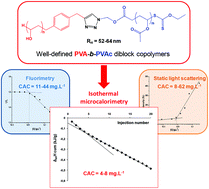A series of well-defined poly(vinyl acetate)-b-poly(vinyl alcohol) (PVAc-b-PVA) amphiphilic diblock copolymers with different hydrophilic block sizes were synthesized by a combination of macromolecular design via the interchange of xanthates (MADIX) polymerization and copper-catalyzed Huisgen's click reaction (CuAAC). Poly(vinyl acetate)s were first prepared by MADIX polymerization using new chain transfer agents bearing clickable moieties. After the hydrolysis of PVAc homopolymers under basic conditions, PVAc-b-PVA copolymers were synthesized using Huisgen's reaction with copper catalysis. Then, the self-assembly in water of PVAc-b-PVA was studied by dynamic light scattering (DLS), static light scattering (SLS), pyrene fluorescence and isothermal titration calorimetry (ITC). The dependence between the hydrophilic chain length of the copolymer and the critical aggregation concentration (CAC) value has been proved. The three different methods of characterization showed similar results, the CAC increasing with hydrophilic block length. Additionally, ITC has proved to be a very valuable technique for the study of self-organization of amphiphilic copolymers.

